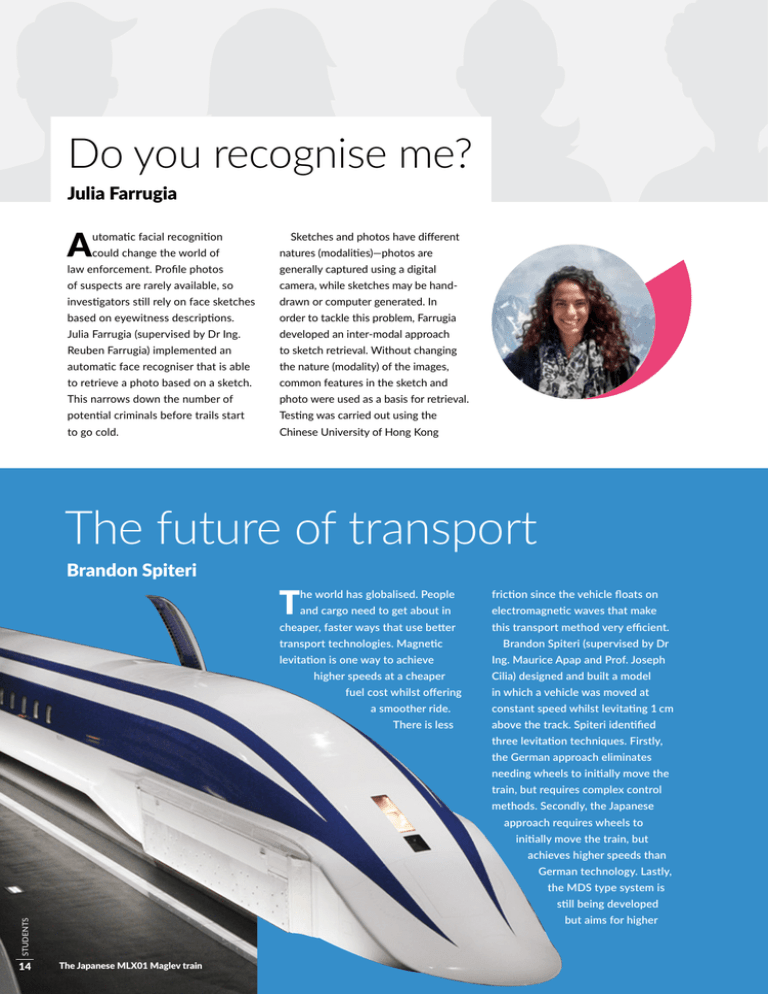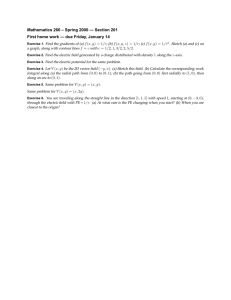Do you recognise me? A Julia Farrugia
advertisement

Do you recognise me? Julia Farrugia A utomatic facial recognition could change the world of Sketches and photos have different natures (modalities)—photos are law enforcement. Profile photos generally captured using a digital of suspects are rarely available, so camera, while sketches may be hand- investigators still rely on face sketches drawn or computer generated. In based on eyewitness descriptions. order to tackle this problem, Farrugia Julia Farrugia (supervised by Dr Ing. developed an inter-modal approach Reuben Farrugia) implemented an to sketch retrieval. Without changing automatic face recogniser that is able the nature (modality) of the images, to retrieve a photo based on a sketch. common features in the sketch and This narrows down the number of photo were used as a basis for retrieval. potential criminals before trails start Testing was carried out using the to go cold. Chinese University of Hong Kong The future of transport Brandon Spiteri T he world has globalised. People friction since the vehicle floats on and cargo need to get about in electromagnetic waves that make cheaper, faster ways that use better transport technologies. Magnetic levitation is one way to achieve higher speeds at a cheaper fuel cost whilst offering a smoother ride. There is less this transport method very efficient. Brandon Spiteri (supervised by Dr Ing. Maurice Apap and Prof. Joseph Cilia) designed and built a model in which a vehicle was moved at constant speed whilst levitating 1 cm above the track. Spiteri identified three levitation techniques. Firstly, the German approach eliminates needing wheels to initially move the train, but requires complex control methods. Secondly, the Japanese approach requires wheels to initially move the train, but achieves higher speeds than German technology. Lastly, the MDS type system is still being developed Students but aims for higher 14 The Japanese MLX01 Maglev train Photos used with permission: X. Wang and X. Tang, “Face Photo-Sketch Synthesis and Recognition,” IEEE Transactions on Pattern Analysis and Machine Intelligence (PAMI), Vol. 31, 2009 (CUHK) student database, which match between sketch and photo. To filtering the photos according to contains 188 photo-sketch pairs. improve these results, texture features gender and by experimenting on larger The implementation makes use of of the query sketch and each photo in datasets with subjects from different an Active Orientation Model (AOM), the dataset were extracted using Local ethnicities, wearing glasses, or having which is freely available. 68 strategic Binary Patterns (LBP). The distance facial hair. Advancements in computer points on a query sketch and suspect was again calculated but included the vision means that soon humans will photo are plotted. Dots depict features texture features. The results were then not be the only eyes narrowing down like eyebrows, hairline, and nose. The merged with the distances obtained possible suspects. distance was calculated between the using the AOM method. Giving a higher respective points on the sketch and priority to the distances obtained using This research was carried out as part photo. The smaller the difference the texture features increased the of a Bachelor of Science in Computer in distances, the closer the match. recognition rate to 60.11%. Engineering at the Faculty of ICT, 55.85% of tests resulted in a correct Results could be improved by University of Malta. The model built by Spiteri, levitating over the track. speeds than the German model The strength and polarity of the a less polluting and more efficient without the need for wheels. electromagnet varies with the size system. Fresh graduates Justin Zarb and direction of the electrical current and Luke Lapira recently proposed model by using an industrial-power passed through it. By manipulating a plan called Maltarail (elevated, DC motor. Levitation was achieved by the electromagnets the vehicle moved suspended trains running on a single using magnets of similar polarity that forward. The built model achieved a rail) to government. This project has repel each other. Opposing permanent top speed of 1.41 km/hr. In his study, been submitted to the European magnets were installed on the track Spiteri proved the energy efficiency Investment Initiative. Such a project and vehicle. Permanent magnets of these systems: the model uses would place Malta on par with retain their magnetic properties the same energy as a 12 W bulb, European transport leaders. (North and South poles) even when much less than a train on wheels. no current or electromagnetic field is Magnetic levitation will shape the This research was carried out as present. The train moved by having future of transportation worldwide. part of a Bachelor of Engineering permanent magnets on the track Monorail may be vital to reduce at the Faculty of Engineering, and electromagnets on the vehicle. Malta’s transport problems to have University of Malta. Students After this research, Spiteri built a 15



